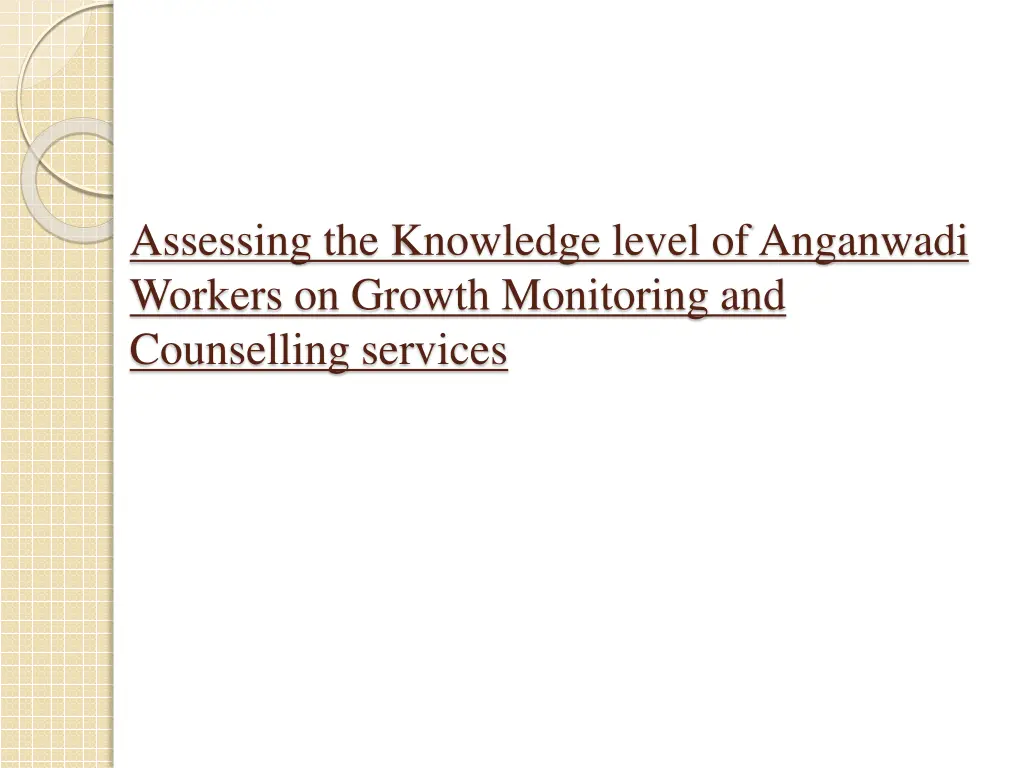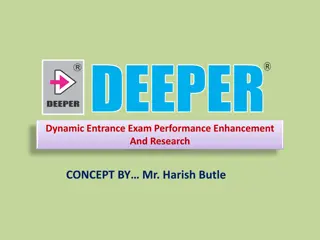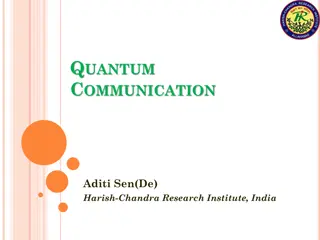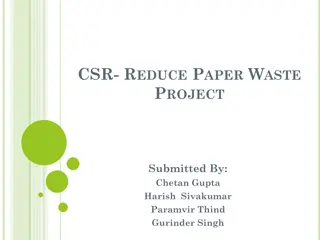
Anganwadi Workers' Knowledge Level Assessment on Growth Monitoring and Counseling
Assessing the knowledge level of Anganwadi workers on growth monitoring and counseling services in rural areas of Jamnagar district, Gujarat. The study aims to understand their socio-demographic characteristics, assess services provided, identify problems faced, and collect data on awareness regarding child growth monitoring. A cross-sectional descriptive study was conducted, with data collected through face-to-face interviews using a structured schedule. Primary and secondary sources were utilized for data collection.
Download Presentation

Please find below an Image/Link to download the presentation.
The content on the website is provided AS IS for your information and personal use only. It may not be sold, licensed, or shared on other websites without obtaining consent from the author. If you encounter any issues during the download, it is possible that the publisher has removed the file from their server.
You are allowed to download the files provided on this website for personal or commercial use, subject to the condition that they are used lawfully. All files are the property of their respective owners.
The content on the website is provided AS IS for your information and personal use only. It may not be sold, licensed, or shared on other websites without obtaining consent from the author.
E N D
Presentation Transcript
Assessing the Knowledge level of Anganwadi Workers on Growth Monitoring and Counselling services
AIM To assess the current knowledge among anganwadi workers on growth monitoring of children enrolled in anganwadi centre and counselling of beneficiaries.
OBJECTIVES To understand the Socio-demographic characteristics of anganwadi workers To assess the services provided by anganwadi workers and their knowledge regarding the services. To identify the problems faced by anganwadi workers while delivering health services at Anganwadi Centre areas
METHODOLOGY: Study Period: March 2014-April 2014 Study Design: Cross-sectional descriptive study Study area: The study was conducted in Jodiya, Dhrol, Lalpur and Jamnagar rural blocks of Jamnagar district of Gujarat and 50 anganwadi centres were selected randomly from each block.
Study Group: The sample for the present study comprises of 50 Anganwadi workers belonging to four Blocks of Jamnagar District. In the study10 AWWs from Jodiya, 10 AWWs from Dhrol and 15 AWWs from Jamnagar rural and 15 AWWs from Lalpur. The nature and purpose of the study was explained to Anganwadi worker. The study was carried out with AWW consent and co- operation. The line listing of all AWCs was made for each block and the AWCs were selected randomly by a random number table.
Tools Applied: A face to face interview schedule was used as a tool for data collection with various questions framed on the knowledge among Anganwadi workers regarding the services of ICDS. Major content of the interview schedule was: socio- economic and demographic profiles of AWWs, Knowledge about various ICDS services especially growth monitoring under AWC done by AWW.
Data Collection: Quantitative and Qualitative study design was followed to collect necessary information on Anganwadi workers awareness regarding growth monitoring of Children. Data were collected personally by making personal visits to Anganwadi centres. Data was collected both from primary and secondary sources. Primary data was collected from all the Anganwadi workers. The secondary data was collected from official records, journals and literature form social science discipline and Guidelines.
Data Analysis: The data obtained was compiled and tabulated using the SPSS software along with Microsoft Excel wherever required. Univariate and Multivariate analysis is performed to address above objective.
Age of the anganwadi workers 60 50 50 40 32 30 20 16 10 4 0 18-29 30-39 Age of aganwadi workers 40-49 50-59
Education Qualification of aanganwadi workers 40 36 24 upto 10th 12-Nov graduate or above
Years AWW working in same AWC 45 42 40 35 30 30 25 18 20 15 10 10 5 0 less than 3 years 3-5 years 5-10 years more than 10 years
The knowledge of the Anganwadi worker regarding the weight gain by children per month Don't have Knowledge regarding weight gain 33% 67% Have knowledge regarding weight gain
Knowledge about weight gain Yes no Work Experience less than 3 Year Count 0 5 % within Work Experience .0% 100.0% 5 years Count 2 7 % within Work Experience 22.2% 77.7% 5-10 Years Count 7 8 % within Work Experience 46.7% 53.3% More than 10 Years Count 13 8 % within Work Experience 62% 38% Total Count 22 28 % within Work Experience 44% 56%
The knowledge of the Anganwadi worker regarding Electronic weighing machine 25% Knowledge about EWM No Knowledge of EWM 75%
The knowledge of the Anganwadi worker regarding WHO Growth Chart 13% YES NO 87%
9% Know regarding MUAC Tape Don't Know regarding MUAC Tape 91%
Problems faced by anganwadi workers Type of problem Yes No Number % Number % Inadequate salary 20 40 30 60 Infrastructure 36 72 14 28 related Logistics Supply 43 86 7 14 related Work overload 48 96 2 4 Excessive record 50 100 0 0 maintenance Lack of help from 6 12 44 88 community Inaccessibility of 22 44 28 56 superiors
CONCLUSION The study findings highlight that 100% of AWWs having the knowledge regarding the services provided under ICDS at AWC. In terms of knowledge regarding the weight gain by the children 67% of AWWs don t have proper idea and knowledge. 75% of AWW don t know how to use the electronic weighing machine to weight the children even after the training. Depending on response to question regarding the growth chart 87 % of AWW know the importance of growth chart and the colour difference provided in growth chart and for what colour code stand for . Almost 91% of Anganwadi worker don t know how to use the MUAC tape.
RECOMMENDATIONS Requirement of refresher training of all AWWs regarding the ideal weight gain of children at specific age. Proper re-orientation of Electronic Weighing Machine at SEJA level or Block level of AWW required. This can be done by providing training hierchically ,i.e. training of supervisors, block co-ordinators and CDPOs at block level who can further train the AWWs. Training and Counselling of Anganwadi Worker regarding the importance of MUAC Tape and using of tape along with Weighing the child to identify the malnourished child.






















